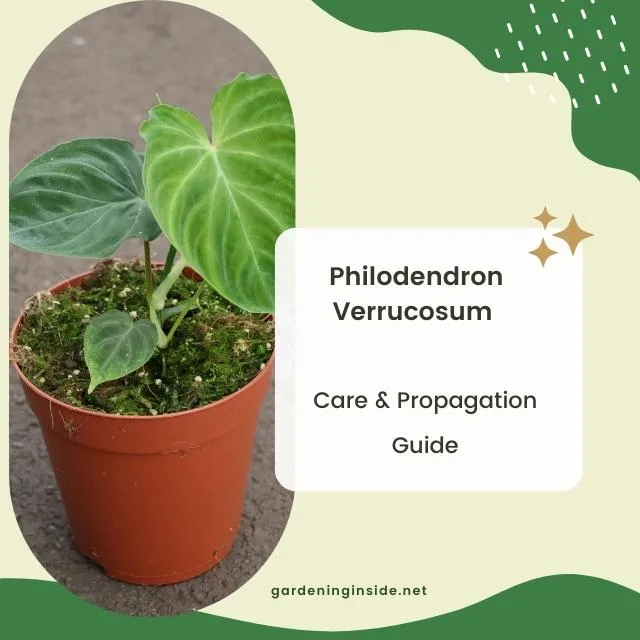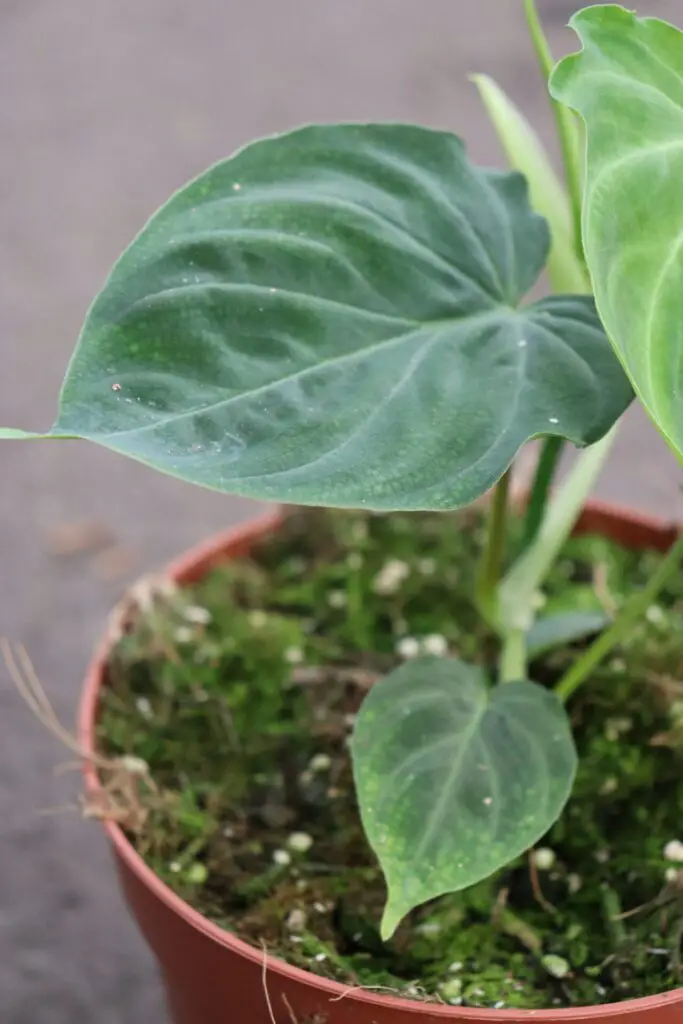Philodendron verrucosum, also known as Ecuador Philodendron, is one of the most elegant varieties of all Philodendrons. It captures everyone’s attention in your plant assortment with its dark green leaves with brilliant ribbing.
Philodendron verrucosum has a ton of various assortments. This particular one has heart-shaped leaves with a velvety surface, dark green tone, and light green veining since this is one more tropical plant that began in the rainforests of Ecuador, backup for fragile water and moistness system.
An exquisite climbing plant, the Philodendron verrucosum is generally particular and requires exact regard for components like dampness and temperature. You’ll likewise be prepared to change its lighting and watering. Simultaneously, a sound Ecuador Philodendron will develop rapidly and transform your indoor developing space into a delightful green wilderness in moments.

Characteristics of Philodendron Verrucosum
In the right conditions, this beautiful green plant will grow rapidly. They love to go up, so ensure you have a lot of room for them to climb.
The leaves of Verrusosum are heart-formed and grow from pale yellow to dark green. The stems can grow up to 10 inches, and healthy Philodendrons will develop to 2 or 3 feet tall.
| Scientific name | Philodendron Verrucosum |
| Family | Araceae |
| Genus | Philodendron |
| Habitat | Costa Rica, Panama, Colombia, Ecuador, and Peru |
| Growth habitat | Climbing Plant |
| Common names | Ecuador Philodendron |
Famous and close cousin of this Philodendron includes Philodendron pastazanum and the famous Philodendron gloriosum. some other varieties include:
- Philodendron Sodiroi
- Philodendron Hastatum
- Philodendron Brasil
- Philodendron Micans
- Philodendron Brandtianum
Care Guide of Philodendron Verrucosum
Philodendron verrucosum is a challenging plant to grow the Verrucosum happy and healthy.
Light Requirements
Philodendron verrucosum requires moderate, indirect sunlight to thrive.
Temperature Requirements
Philodendron’s habitat is warm and humid, so they love warmth. The ideal temperature for the growth of Philodendron verrucosum is about 65-80 degrees Fahrenheit (18-26oC).
Although the plant likes a warm atmosphere, a high temperature can stress it out.
Water Requirements
Philodendron verrucosum prefers consistent watering—water when the top 2 inches of soil gets dry.
Don’t let the soil dry completely. Verrucosum cannot tolerate water deficiency, and the leaves start to fall.
Humidity Requirements
Philodendron Verrusocum grows well in high humidity. For best growth, maintain humidity up to 90%.
The plant tolerates humidity of 50%, but the growth will be slower.
Soil and Fertilizer Requirements
Philodendrons like their soil light aerated rather than water-logged and suffocating on its roots. Overly watered soil will cause root rot, and ultimately the plant will die.
Fertilization is recommended in the growth period of the plant. The philodendrons are not heavy feeders. In winters, let the plants rest and do not fertilize them.
Pruning Philodendron Verrucosum
Pruning of Philodendron verrucosum is not a problem. The plant does not require pruning unless you want to reduce plant size. But why would you do that?
How to repot Philodendron Verrucosum?
Once the plant becomes root bound, the roots require space for plant growth. Inhibited plant growth and yellow and dull leaves also indicate that the plant needs to be repotted.
To check the root system, gently pull the plant out of the pot and plant it in a bigger pot.
Spring season is ideal for repotting but can be done whenever required.
Also Read: Begonia Tamaya Care & Propagation with Problems & Solutions

Propagation of Philodendron Verrucosum
Philodendron Verrusocum can be propagated easily by stem cuttings.
- Philodendron verrucosum begin their lives as epiphytes, so their airborne roots make them simple to spread through stem cuttings. These plants can be propagated in the soil as well as in water.
- You can rapidly end up spreading various cuttings from one mother plant.
- For propagation, cut a 6-inch stem and squeeze off a few arrangements of leaves, so you have no less than two leaf nodes on the stem.
Philodendron verrucosum takes to water, so you can undoubtedly propagate it that way. You can likewise put cuttings in moss and allow it to develop. Or, on the other hand, you can move it straight into another pot: a blend of very light soil will do pleasantly.
Philodendron Verrucosum Common Problems and Solutions
Like other plants, this Philodendron may also face a few growing problems. The issues associated with this plant are:
Yellow Leaves
Overwatering Philodendron can result in yellow leaves.
Maintain a proper watering schedule to avoid this problem.
Drooping Leaves
Drooping leaves can be caused by under or over watering.
Maintain proper watering, check the plant for root rot and change soil if required.
Root rot
The plant is sensitive to watering. Overwatering can also result in root rot. Another reason for root rotting may be fungus.
Ensure the drainage is appropriate, and use pesticides in case of fungus.
Pests and Diseases
Philodendron Verrucosums are prone to Mealybugs, Fungus Gnats, Aphids, Whiteflies, and Spider mites.
To get rid of these pests, rubbing alcohol, some soap solution, or insecticidal soap may wipe the little critters away.
Toxicity
Philodendron verrucosum plant contains calcium oxalate crystals, which is toxic to pets and humans.
Conclusion
Philodendron verrucosum is not difficult to focus on as a houseplant. To care for the Philodendron verrucosum maintain a warm atmosphere of about 65-85°F, humidity greater than 50%, and place the plant where it gets plenty of indirect sunlight. The preparing blend ought to be aerated, all around depleted, and wealthy in natural matter.
Make sure to water this plant when the main few inches of the preparing blend feel dry, and feed it once every month with reasonably diluted fertilizer. Likewise, you ought to report it each 2-3 years, and remember to give it a climbing symbol or greenery post.
Happy Gardening!!!
Frequently Asked Questions about Philodendron Verrucosum
Is Philodendron verrucosum rare?
Philodendron verrucosum is rare because it’s not as common as other philodendrons and can be challenging to find locally.
Why is my Philodendron verrucosum yellow?
Philodendron verrucosum can get a little dramatic if they don’t receive regular moisture and will display yellowing or even dropping of their leaves.
Why are my Verrucosum leaves curling?
Underwatering the philodendron verrucosum can cause the leaves to curl and brown leaf tips.
Do all Verrucosum have fuzzy stems?
Philodendron verrucosum is well known for having fuzzy stems (petioles) which look like hairs.
What is a Philodendron verrucosum mini?
Philodendron verrucosum mini is an Ecuadorian clone that stays under 5-inch leaves.
What is the most common Philodendron?
Philodendron hederaceum is probably the most popular philodendron type you can find worldwide.
What is the rarest Philodendron?
The rarest Philodendron on this list is the Philodendron Spiritus Sancti.
